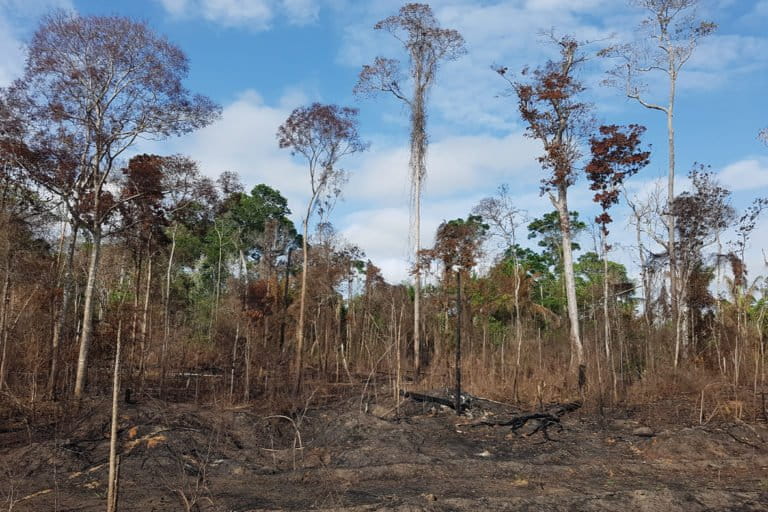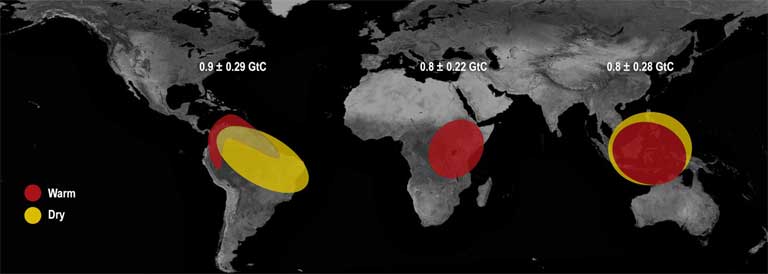- New research shows how a combination of high temperatures, intense drought, and human-caused fires resulted in dramatic forest loss in the Lower Tapajós Basin in the Brazilian Amazon.
- According to the authors, forest reduction meant that one of the world’s largest carbon sinks generated almost 500 million tons of CO2 emissions, an amount higher than the annual emissions of developed countries such as the U.K. and Australia.
- Due to climate change, more frequent extreme droughts are predicted to affect most of the Amazon basin in this century; in this scenario, the 2015 El Niño could be seen as a window into the future.
The great drought and megafires that the Amazon experienced in recent years caused the death of 2.5 billion trees and vines in the Lower Tapajós River Basin, one of the most biologically rich regions of the Amazon and home to a large number of Indigenous groups and traditional river communities.
This ecological catastrophe is a consequence of a particularly intense El Niño period between 2015 and 2016. El Niño is a climate pattern associated with a warming of Pacific Ocean currents that has a global influence on the weather. The result of the die-off is not only evident in the landscape but its effects are now quantified as greenhouse gas emissions in a recent study.
According to scientists, the intense drought made a tropical forest, one of the world’s largest carbon sinks, into a massive source of emissions, generating an estimated 495 million tons of CO2 over three years. This is from an area that represents only 1% of the whole Amazon rainforest biome and is the equivalent of burning more than 4.2 billion barrels of oil.


These findings are part of research carried out by scientists from U.K. and Brazilian universities, Brazil’s National Institute for Space Research (INPE), the National Institute of Amazonian Research (INPA), the Stockholm Environment Institute, and the eastern Amazonian office of the Brazilian Agricultural Research Corporation (Embrapa).
Their study, “Tracking the impacts of El Niño drought and fire in human-modified Amazonian forests,” was recently published in the journal Proceedings of the National Academy of Sciences (PNAS).
The authors focused on the Lower Tapajós region in the eastern Amazon, an area that constitutes both virgin and human-altered forests, and is under intense development pressure from agriculture expansion, infrastructure development, mining, and logging.
From 2015 to 2016, a 6.5-million-hectare (16-million-acre) area was also the Amazonian epicenter of that year’s El Niño event. The massive die-off of trees and vines occurred while temperatures rose 1.5 to 2° Celsius (2.7 to 3.6° Fahrenheit) higher than observed during previous El Niño periods. Simultaneously, the intensity of the dry season, measured by water deficit, was the highest in the 19-year record included in the study.

‘A window into the future’
To understand the combined impacts of El Niño, drought and fires, researchers conducted quarterly surveys from October 2015 to October 2018 in which they monitored the fate of 6,117 stems in 21 long-term plots.
“We analyzed whether every single individual in our plots were alive or dead,” lead author Erika Berenguer, from Lancaster University and the University of Oxford, told Mongabay in an email. “This monitoring lasted for three years and included more than 6,000 trees, palms, and lianas. We started before the 2015 El Niño and continued to do it both during and after it.”
Berenguer said they made three main findings: first, tree mortality remains above expected levels for three years in forests affected by El Niño drought, and two and a half years in forests affected by drought and fire. “This long-term effect had not been quantified before,” she said.
Second, trees located in forests that had been previously affected by human disturbance, such as selective logging and understory fires, were more likely to die following the drought and fires, demonstrating that human-modified forests are less resilient.
And third, there were emissions of 495 million tons of CO2, an amount higher than the annual emissions of developed countries such as the U.K. and Australia. “This is crucial to show that the disturbances happening in the Amazon can have significant global impacts,” Berenguer said.

She added they did not expect to find such high levels of tree die-off. Among trees in the study plots with a diameter at chest height of at least 10 centimeters (4 inches), the mortality rate was around 75%; for smaller trees, it was 90%. “Still, we did not expect that, at the regional level, the figure would be in the billions!” Berenguer said.
She said the findings from the study are important because they show the highly negative impacts that an intense drought, especially its associated fires, can have on tree mortality and, consequently, on CO2 emissions.
“While the next extreme drought is not avoidable, fires are, as these need to be started by humans. As such, it is crucial to develop more efficient fire management strategies in Amazonia,” Berenguer said.
Paulo Brando, assistant professor at the Department of Earth System Science at the University of California, Irvine, said he agreed with Berenguer. He said the Amazon could provide much more effective services if fires and other drivers of forest degradation were not so prevalent. “Forests can recover from episodic droughts but have a much harder time when other disturbances caused by human activities come along,” Brando said in an email.

According to Brando, who was not involved in this particular research (although he has studied droughts and fires in the Amazon extensively), these new findings are relevant because very few studies have looked into so much detail on the response of tropical forests to drought and fire.
“What the authors found is surprising. Drought-stressed trees can experience increased mortality for many years, probably due to the damage caused to their hydraulic systems. And the magnitude of the mortality is high, being capable of changing the carbon balance of the entire region,” Brando said.
However, he said the new findings are not necessarily evidence of a “tipping point.” Instead, he said the research stresses really well “what scientists already know: that Amazon forests have a high but limited resilience to multiple stressors.”
“What is new and important is the quantification of how much stressors impair the capacity of tropical forests to play a more important role in stabilizing climate through carbon storage. It also highlights that the changes in climate and land use that are happening across large portions of the Amazon could cause similar changes. Whether or not we call that a tipping point or early signals of widespread degradation is debatable but beyond the point,” Brando said.

Berenguer said there need to be more studies into the consequences of El Niño because of its close relationship with climate change, since increasing temperatures will result in more extreme droughts.
“While there has been plenty of studies showing the impacts of previous droughts, most were not following through time the impacts of the drought, so we did not understand the duration of its effects on tree mortality. No study to date had tracked tree mortality before and after a wildfire, only following experimental ones,” Berenguer said.
Researchers say more frequent extreme droughts are predicted to affect most of the Amazon Basin this century due to climate change. “As such, the 2015 El Niño could be seen as a window into the future, from which we can have valuable insights into the magnitude of the impacts of these extreme droughts,” Berenguer said.
Citation:
Berenguer, E., Lennox, G. D., Ferreira, J., Malhi, Y., Aragão, L. E. O. C., Barreto, J. R., … Barlow, J. (2021). Tracking the impacts of El Niño drought and fire in human-modified Amazonian forests. Proceedings of the National Academy of Sciences, 118(30). doi:10.1073/pnas.2019377118
Banner image: Lead author, Dr. Erika Berenguer, measuring trees in an Amazonian forest that burned during the 2015 El Niño. Image courtesy of Marizilda Cruppe/Rede Amazônia Sustentável.
